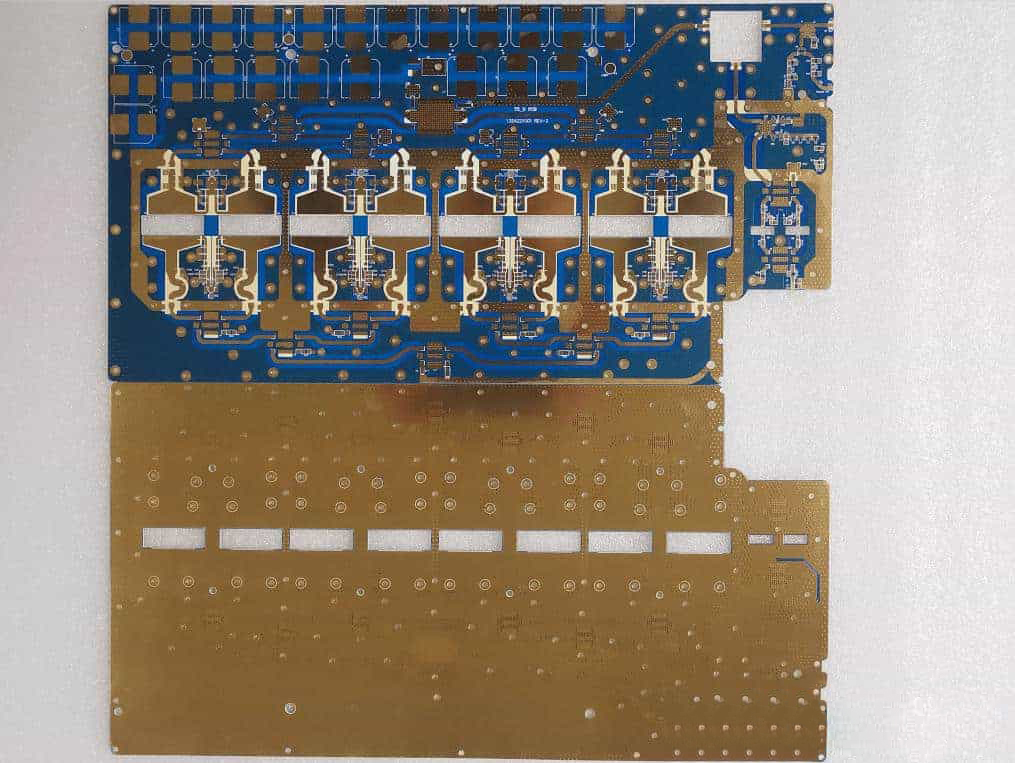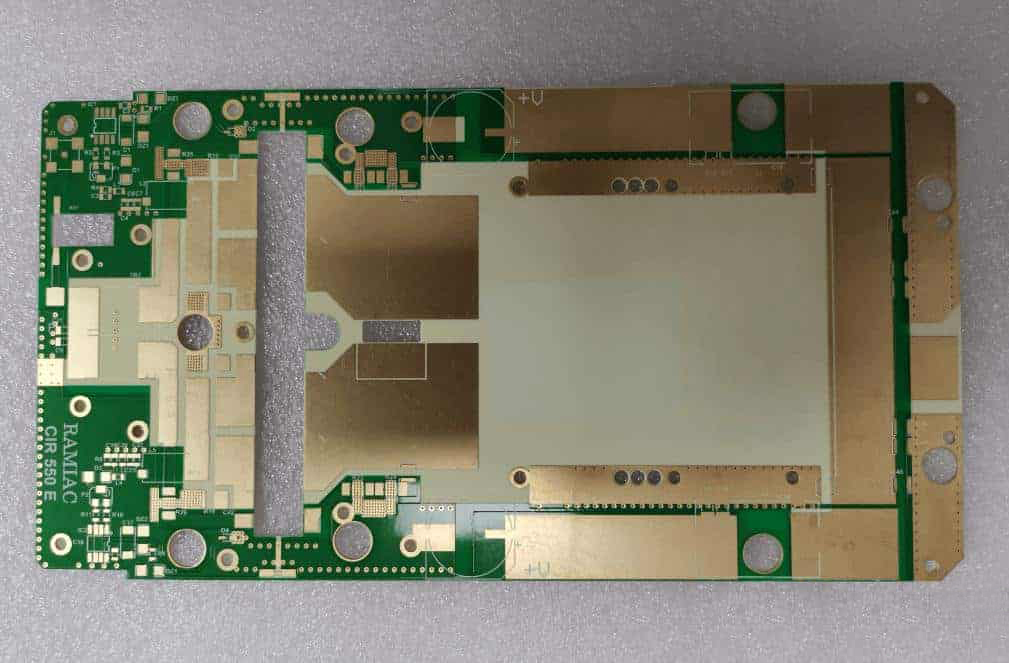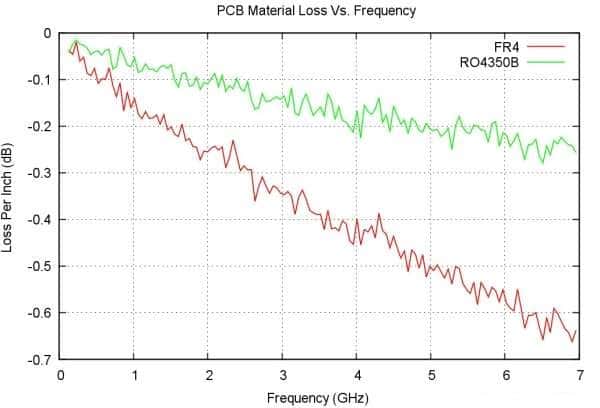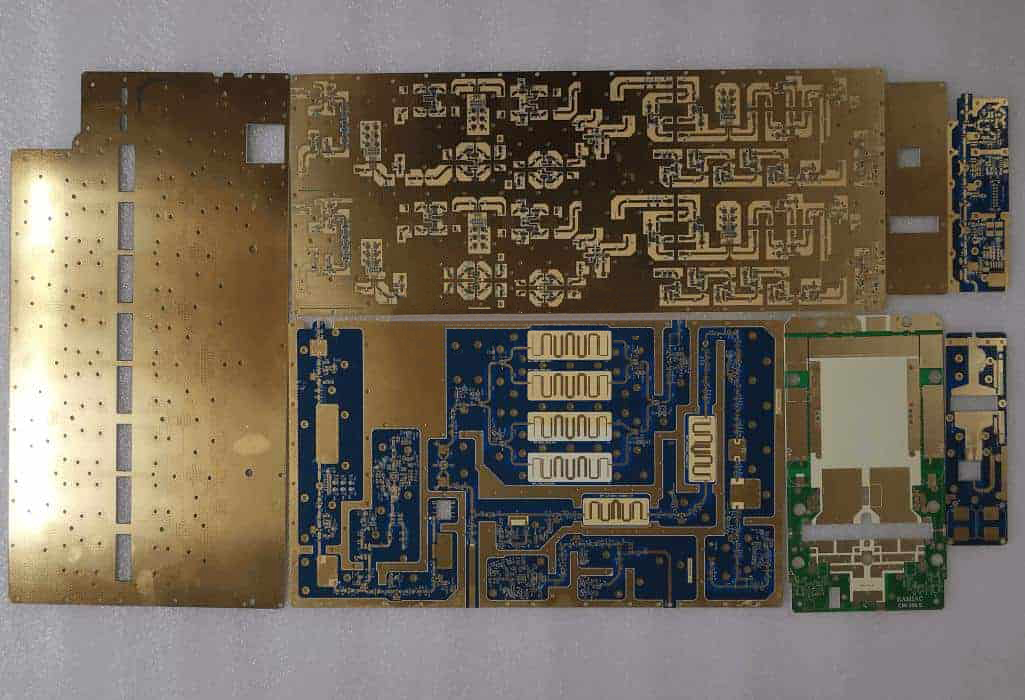The Best Rogers PCB Manufacturer in China

Rogers PCB is a type of high-frequency board that raw material is produced by Rogers company. It is different from the conventional PCB board—epoxy resin (FR4). It has no glass fiber in the middle and uses a ceramic base as the high-frequency material. Rogers has superior dielectric constant and temperature stability. Its dielectric constant thermal expansion coefficient is very consistent with copper foil, which can be used to improve the deficiencies of PTFE substrates. It is very suitable for high-speed electronic design, commercial microwave, and radio frequency applications. Its low water absorption is ideal for high-humidity applications, providing customers in the high-frequency board industry with the highest quality materials and related resources, which fundamentally enhance product quality.
ROGERS 4003C and ROGERS 4350B have excellent low dielectric loss characteristics. As a result, they provide a more cost-effective and processable high-frequency material selection than PTFE. They are widely used in antennas of the cellular base station and power amplifiers, microwave point-to-point connection (P2P), automotive radars and sensors, radio frequency identification (RFID), direct broadcast satellite high-frequency head (LNB), and other fields. In addition, the thermal expansion coefficient of the X and Y-axis is similar to that of copper. The expansion coefficient of the Z-axis is much lower than FR4 (46ppm/ oC) and has a higher Tg value (>280oC), thus ensuring good thermal stability. The dimensional stability and high reliability of the entire product in PCB processing and assembly will bring more benefits to the design of multilayer circuits.

When the circuit’s operating frequency is above 500MHz, the range of materials that design engineers can choose is significantly reduced. Rogers RO4350B material allows RF engineers to conveniently design circuits, such as network matching and impedance control of transmission lines. Due to its low dielectric loss characteristics, in high-frequency applications, RO4350B material has more advantages than ordinary circuit raw materials. Its dielectric constant with temperature fluctuation is almost the lowest among similar materials. In a wide frequency range, its dielectric constant is also relatively stable at 3.48; the recommended design value is 3.66. LoPra copper foil can reduce insertion loss, which makes the material suitable for broadband applications.
XDF always has all the thickness and specifications of RO4003C, RO3003C, RO4350B, RO5880, RO5870, and RO4450F prepregs, which can meet your immediate response needs. We have rich experience in RFID data process engineering and a complete high-frequency material processing control system to ensure product design functions.

In PCB prototyping, Rogers is a unique circuit board with a specific technical threshold, difficult to operate, and high cost. General PCB factories rarely fulfill orders due to the troublesome production methods and the small number of customer orders. XDF is engaged in the PCB prototype manufacturer of Rogers high-frequency PCB boards, which can meet the various high-frequency PCB needs of customers. Currently, it can achieve 4~10 layers of ceramic pure pressure and 4~12 layers of mixed pressure.
XDF is very proud of supporting the military. We were contracted to assemble a PCB for use in a military communications application and provided Rogers 4350, Rogers 4003, and RT5880 material assembly services. There are no MOQ 1 panelization is ok. We will perform final testing using automated optical inspections and x-ray inspection prior to product delivery. There will be strict impedance control following specification with a testing report.
With services (special 5G application) from consumer to military PCB industries, we continuously strive to build Rogers PCB products that exceed your expectations, develop long-term customer relationships, and become your best possible manufacturing partner.
Do you produce Mix-press rogers PCB with other raw materials?

XDF stocks most of rogers material model in our warehouse, and we produce pure Rogers PCB or mix-press PCB boards: FR4+Rogers PCB and Aluminum+Rogers PCB. If you have a special design and material request, please send your design and requirement to sales@pcba360.com with your PCB stack-up. If you need design suggestions and consultation, you are welcome to contact us.
Rogers PCB materials are generally in stock with different thickness :
♦ Rogers 4350B
♦ Rogers 4003C
♦ Rogers 3003
♦ Rogers 5880/RT5880
♦ RT5870
………..
There are high market demands for Rogers 4350B, and we keep all types of Rogers 4350B material in stock. If you need pricing information for Rogers 4350B PCB or RT5880, please send your inquiry to sales@pcba360.com. We will reach out with a quote shortly.
In order to support R&D for universities and institutions, bare Rogers substrate is for sale at a competitive price, even with small quantity orders. Please contact XDF for more information.
Rogers PCB enables step changes in high-frequency, high-speed performance for wired & wireless communications circuits worldwide with Advanced Circuit Material. Key Products/Brands include: RT/duriod® High-Frequency Laminates; RO4000® High-Frequency Circuit Materials; RO3000® High-Frequency Laminates; and TMM® Thermoset Microwave Materials. For applications: Wireless Base Stations; Aerospace & Defense; Automotive; and High-Speed Digital.
Why Choose Rogers Printed Circuit Boards?
As 5G Technology develops, more and more devices request high-performance high-frequency PCBs and RF PCBs that need low signal losses and low electrical noise. Rogers PCB materials are cost-effective and perfectly meets the required technological requirements.

Rogers PCB Applications:
1.5G Station
2.Cellular Base Station Antennas and Power Amplifiers
3.Automotive Radar and Sensors
4.Microwave point to point (P2P) links
5.LNB’s for Direct Broadcast Satellites
6.Microwave equipment of all kinds.
7.RF Identification (RFID) Tags
Rogers vs. FR4
Here is a comparison between FR4 and Rogers PCB material. Almost 80% of electronic circuit boards are manufactured with FR4 material. What is the difference between FR4 material and Rogers PCB material?
Here is a comparison chart:

All RF boards need to control signal loss. From the diagram, Rogers PCB material performs better than FR4. As 5G is on the horizon, Rogers PCB market will increase, and prices will decrease. If your design involves any types of signal transmission, we strongly recommend materials from Rogers.
Rogers Raw Material Manufacturer
With more than 185 years of materials science and process engineering experience, Rogers focuses on delivering superior solutions to meet our customers’ challenges. Three things characterize us:
• Leadership in mission-critical reliability.
• Commitment to market-focused innovation.
• Passion for deliveringexceptional value that enables our customers’
Please refer to our website to learn more about the Rogers Corporation.
With the increasing development of electronic technology, the production of electronic products requires more materials, such as high-frequency materials. For example, Rogers PCB board material is a type of high-frequency board produced by Rogers Company. It is different from the conventional board epoxy resin for PCB. It contains no glass fiber, and it is a ceramic-based high-frequency material. You can find Rogers materials part number list here.
Rogers PCB Material Properties:

RO3000 series: Based on ceramic-filled PTFE circuit materials, the models are: RO3003, RO3006, RO3010, RO3035 high-frequency laminates.
RT6000 series: Based on ceramic-filled PTFE circuit materials, designed for electronic circuits and microwave circuits that require high dielectric constants. The models are: RT6006 dielectric constant 6.15, RT6010 dielectric constant 10.2.
TMM series: composite materials based on ceramics, hydrocarbons, and thermosetting polymers. The models are: TMM3, TMM4, TMM6, TMM10, TMM10i, TMM13i, and many more.
3001 Bonding Film (Thermoplastic Chloro-fluorocopolymer)
RO3000® series High-Frequency Laminates (PTFE/Ceramic)
RO3035® series High-Frequency Laminates (PTFE/Ceramic)
RO3200® series High-Frequency Laminates (PTFE/Ceramic)
RO4000® High-Frequency Laminate with TICER Foil
RO4000® laminates datasheet and fabrication guidelines: RO4003C, RO4350B
RO4400® prepreg datasheet and fabrication guidelines: RO4450B, RO4450F
RO4500® Antenna Grade Laminates for High Volume Applications
RT/duroid® 5870/5880 Glass Microfiber Reinforced PTFE Composites
RT/duroid® 6002 laminate datasheet
RT/duroid® 6006/6010 laminate datasheet
RT/duroid® 6202 laminate datasheet
RT/duroid® 6202PR laminate datasheet
TMM Thermoset laminate datasheet: TMM3, TMM4, TMM6, TMM10, TMM10i
ULTRALAM 2000 laminate datasheet
ULTRALAM 3000 LCP laminate datasheet: ULTRALAM 3850
ULTRALAM 3000 LCP Prepreg: ULTRALAM 3908
LONGLITE™ AND R/flex® Flexible Circuit Materials – Thin Dielectrics
LONGLITE™ Flex 200 Adhesiveless Materials
LONGLITE™ Flex 300 Adhesiveless Series
R/flex® 1000 Circuit Materials for Long-life Dynamic Flexing
R/flex® 1100 Circuit Materials – High-Temperature Laminates
R/flex® 1500 Assembly Adhesive
R/flex® 2001 Laminates and Coverfilms
R/flex® 2005 Laminates and Coverfilms
8080 Liquid Photoimageable Covercoat datasheet
8080 Liquid Photoimageable Covercoat: LP11
8080 Liquid Photoimageable Covercoat: LP2
R/flex CRYSTAL 7500 Laminates and Coverlayers
R/flex CRYSTAL 7700 Laminates and Coverlayers
R/flex JADE A coverfilm datasheet
R/flex JADE A laminates datasheet
R/flex JADE J coverfilm datasheet
R/flex JADE J laminate datasheet
Find a Rogers PCB manufacturer and supplier. Choose quality Rogers PCB manufacturers, suppliers, exporters at PCBA360.com. You are welcome to send your design to Sales@pcba360.com for inquiry.
Rogers PCB: All the Crucial Details
It is a well-documented fact that circuit boards are vital for electronics, something that you must know as an electronics enthusiast. Therefore, getting everything right, ranging from the material choice to the PCB manufacturing company, becomes pivotal. As you would expect, XDF PCB and Assembly can provide you with high-quality printed circuit board manufacturing and assembly. However, diverse printed circuit board materials exist, including HDI materials, FR4, and Rogers PCB material.
So what material should you use when it comes to your PCB production needs? This article will focus on Rogers PCB and everything else you need to know regarding this PCB material.
Rogers Printed Circuit Board
We all hear about Rogers PCB, but very few of us understand what it is. So what does it all entail? The term Rogers implies a manufacturing company that produces the laminate material deployed in the fabrication of printed circuit boards. The material comes as an FR-4 core, complete with a copper laminate. Consequently, this material gets referred to as Rogers FR4.
It is also prudent to know that the core materials from Rogers have an established reputation when it comes to better high-frequency properties. While more expensive, Rogers PCB laminates (fr4) prove less lossy under high frequencies, making them perfect as RF circuit boards. At this moment, you might wonder if there is a difference between Rogers PCB material and an FR-4 material. So is there a distinction?
Yes, a distinction exists between a Rogers PCB material and an FR-4 material, as much as the Rogers material contains an FR-4 in its core. Below, some of the most notable differences between the two PCB materials.
The distinction between Rogers Material and an FR-4 Material
• Rogers material is more expensive compared to an FR-4 material
• The quality of a Rogers PCB material proves higher than an FR-4 material
• A Rogers material possesses a lower dissipation factor (DF) compared to an FR-4 material and thus suffers lesser signal losses.
• Rogers material possesses a wider Dk (dielectric constant) range than an FR-4 material and thus has more impedance stability.
• A Rogers’s material contains a higher Dk of 6.15 to 11 compared to an FR-4 material that possesses a Dk of 4.5
• A Rogers’s material also contains a better temperature or thermal management due to its limited variation than FR-4 material.
• A Rogers’s material also improves the impedance control in a better way compared to an FR-4 material.
As demonstrated, the application of Rogers PCB laminates is superior to that of standard FR-4 material and proves its usefulness in a printed circuit board. However, to get your PCB developed by this laminate and to the highest standards, you need to find a top company among the various Rogers PCB manufacturers out there. But as earlier detailed, XDF PCB and Assembly Company can guarantee you excellent printed circuit board manufacturing and assembly services to your satisfaction. You only have to enclose your Gerber file according to the instructions stipulated to get your Rogers FR4 PCB.
What’s more, the company will provide top-rate quality PCBs based on your PCB needs. It has a demonstrated experience of over 15 years producing Rogers PCBs. Lastly, the dedicated customer support system exists to cater to your Rogers PCB price inquiries and other related aspects that can expedite your Rogers PCB order.
Designing a Rogers PCB
If you want a top performance-driven Rogers printed circuit board, you have to demonstrate your peak powers to the design phase. The design influences the quality of the end-product provided the manufacturer is a top one. So what aspects should you consider when designing your Rogers PCB?
• The CTE or Coefficient of Thermal Expansion. Most materials tend to expand or contract in a temperature change event, which applies to a Rogers material. Therefore, if temperatures rise, the Rogers material expands with the converse holding true as well. However, the expansion gets defined by the glass transition temperature- also inferred as the temperature limit. A higher glass transition temperature implies a better quality and performance of the circuit board. However, if the glass transition temperature gets exceeded, the material will expand and deform. Such a consideration becomes a crucial aspect of the design of a Rogers PCB and any other circuit board. The Rogers PCB material contains a copper layer, and this copper possesses an 18ppm CTE value. Consequently, the copper needs a perfect match for the CTE value because any mismatch compounds the problem. Therefore, it becomes pivotal to understand the CTE value of the Rogers material you intend to use besides other crucial PCB components to ensure everything works out perfectly.
• Dielectric constant. It is another crucial element of the Rogers material that you need to consider in the design phase. It implies the capacity of a material to accumulate electric charge. Therefore, a material with a higher Dk or dielectric constant possesses a higher capacitance and consequently the capacity to handle higher voltages. It represents a crucial aspect of Roger’s printed circuit board and something that you have to consider during the design phase of your PCB.
The dielectric constant also plays a fundamental role in reducing the printed circuit board size. However, when picking the Rogers PCB material type of choice, especially one with high frequencies, you must consider its performance and costs. For instance, if you want a printed circuit board for broadband application or purpose, then opting for a Rogers PCB proves the best bet in your design. The small Dt value of the Rogers PCB ensures functional capability in temperature-sensitive devices such as in a microwave.
• Hygroscopic attribute. The design of your printed circuit board often considers the environment in which it will function. It should not absorb moisture under impractical environmental conditions. The same applies to a Rogers PCB as it has the capability of absorbing moisture. However, the rate at which a Rogers PCB absorbs moisture proves lower than other typical printed circuit boards, and thus the electrical and thermal properties of the Rogers PCB do not get hampered much. All these imply a capability of getting applied in different circumstances without any deterioration in its performance.
• Temperature challenges. The project purview defines the operating temperature range of a printed circuit board materials needed for a specific application in all instances. Therefore, whenever an electronic product’s parts become sensitive to elevated temperatures, the designer needs to account for this by picking a suitable Rogers printed circuit board. It becomes crucial for a PCB to have a regulatory mechanism of reversing higher temperatures than it can handle.
The PCB design needs to account for any temperature variation to avoid instances of some mass loss and later decay with time. Most PCBs require applications with a range of temperature that does not exceed 350 degrees Celsius. Considering that some Rogers PCB materials possess higher decay temperatures, it becomes crucial to consider during the printed circuit board design phase.
• Driver circuit design requirements. The design of any specific driver circuit needs a stable impedance. But considering that the dielectric constant (Dk) range of a Rogers’s PCB material is wider than an FR-4 material, it keeps the impedance stable. Besides this, the performance also gets boosted for these types of printed circuit designs. In most instances, the operations of most circuits at high-frequency work at an impedance value of 50Ω. It also becomes necessary to match this value with other circuit components to ensure the maximum power transfer between output and input. Further, the circuits need to avoid developing plenty of standing waves to eradicate any load reflection.
However, the good news is the existence of a lot of software tools such as the computer-aided-engineering that allow the selection of diverse and crucial specifications for a Rogers printed circuit board design material. Therefore, the deployment of such tools makes it possible to pick Rogers material possessing the preferred dielectric constant to ensure a matching impedance and stability.
• Other crucial factors such as the dissipation factor prove crucial not to get ignored when picking printed circuit board materials. The engineers should consider vital material properties such as the material’s power loss, which elevates as the operating frequency increases. Another vital property entails thermal conductivity that determines the head conductive attributes of the material. For instance, the missile guidance system’s amplifiers can result in electrical and mechanic variations in the PCB material properties whenever heat fails to get managed properly. Consequently, it can lead to malfunctions and serious problems.
The Diverse Rogers PCB Material Types
If you want to design and get your printed circuit board produced, it helps to consider the three types of Rogers PCB materials. The materials can get categorized into three categories, and this includes the following.
• Metal claddings. The first of the three categories. It can come as electrodeposited, rolled, resistive foil, and electrodeposited reverse pickled/treated metal cladding.
• Bonding material. The second category comes as woven glass, hydrocarbon, ceramic PTFE bond ply, prepreg, and TECA (Thermoset Thermal & Electrically Conductive Adhesive) film.
• Different laminates. It comes as the last of the categories and features PTFE ceramic, hydrocarbon, random PTFE glass fiber, glass-reinforced & cross-plied woven PTFE, and modified epoxy laminates with woven-glass reinforcement.
Applications of Rogers PCBs (Printed Circuit Boards)
The Rogers PCBs have numerous applications spanning diverse sectors. It includes the following.
• You can use the Rogers PCB as crucial parts of antennas for the cellular base station, direct broadcast satellite, communication systems, microwave equipment, 5G modern stations, carrier-grade enabled Wi-Fi, etc.
• Automotive industry. The Rogers printed circuit boards can get deployed in automated/mechanized test equipment (ATE), automotive radar, sensors, etc.
• RF Engineering. You can also deploy the Rogers printed circuit boards in power amplifiers, IP infrastructure, RF Identification tags, etc.
• Aeronautic engineering. The Rogers PCB can also get deployed in ACAS or aircraft collision avoidance systems, backhaul radios, microstrip antennas, etc.
• Rogers PCBs also get utilized in DAS and ADAS (advanced driver assistance systems), among other useful computer areas.
• In the military, the Rogers PCB get utilized in radio communication systems, jamming systems, etc.
Benefits of the Rogers Printed Circuit Board
Printed circuit boards developed from the Rogers material have multiple benefits, and these include the following.
• Rogers PCB possesses low moisture absorption and thermal expansion, besides solid dimensional stability under diverse conditions.
• Rogers PCB material possesses high compatibility and simplicity in terms of fabrication because of its thinness (normally 0.1mm)
• It also has exceptional thermal management, making it ideal for circuits and electronic elements or devices producing excess heat.
• Another crucial feature that proves so useful entails reduced outgassing, especially in space applications.
• The Rogers printed circuit board matches the trace dimensions and locations, consequently improving the impedance control.
• Rogers’s printed circuit board offers a stable high-frequency performance.
Frequently Asked Questions (FAQs)
• What do I need to focus on when you consider the mechanical and electrical properties of a Rogers printed circuit board?
Well, you should concentrate on the specific performance requirements. It should include water absorption, thermal expansion, temperature stability, moisture absorption rate, and absorption percentage.
• What other Rogers printed circuit board applications apply?
The application areas of the Rogers printed circuit board are as detailed in the piece. No other application exists beyond the discussed areas. As already discussed, it includes RF applications, medical industry, defense applications, microwave, and mobile networking applications.
• What material aspects should you focus on when addressing the Rogers PCB?
Plenty has to get considered regarding the board material. It includes raw materials like Rogers 4350, ceramic laminates, FR-4 material, copper laminate, dielectric material, high-frequency circuit materials, and composite materials. Additionally, it would be best to concentrate on material technology or advanced materials technologies, advanced materials suppliers, and advanced PCB materials.
• What considerations should you focus on regarding Roger’s PCB assembly process when seeking industry solutions?
It is important to concentrate on the diverse types of printed circuit boards. Additionally, it would help if you considered the laminate material and material processing such as FR-4 and Rogers’ 4350 material. Additionally, you should also consider the copper layers, the multi-layer status of the PCB, and conductive layers.
Final Thoughts
The type of material you decide to have on your printed circuit board proves a weighted subject. It will determine plenty of aspects regarding its applicability in the preferred application areas. You, therefore, have to get this right in the design phase before engaging a PCB manufacturer for its prototyping or production. We hope that the information on this piece has enlightened you on the various aspects of Rogers PCB.
C4 Jinxiongdakejiyuan Huanguannan rd, Guanhushequ, Longhua district Shenzhen China
Certifications

Delivery

<